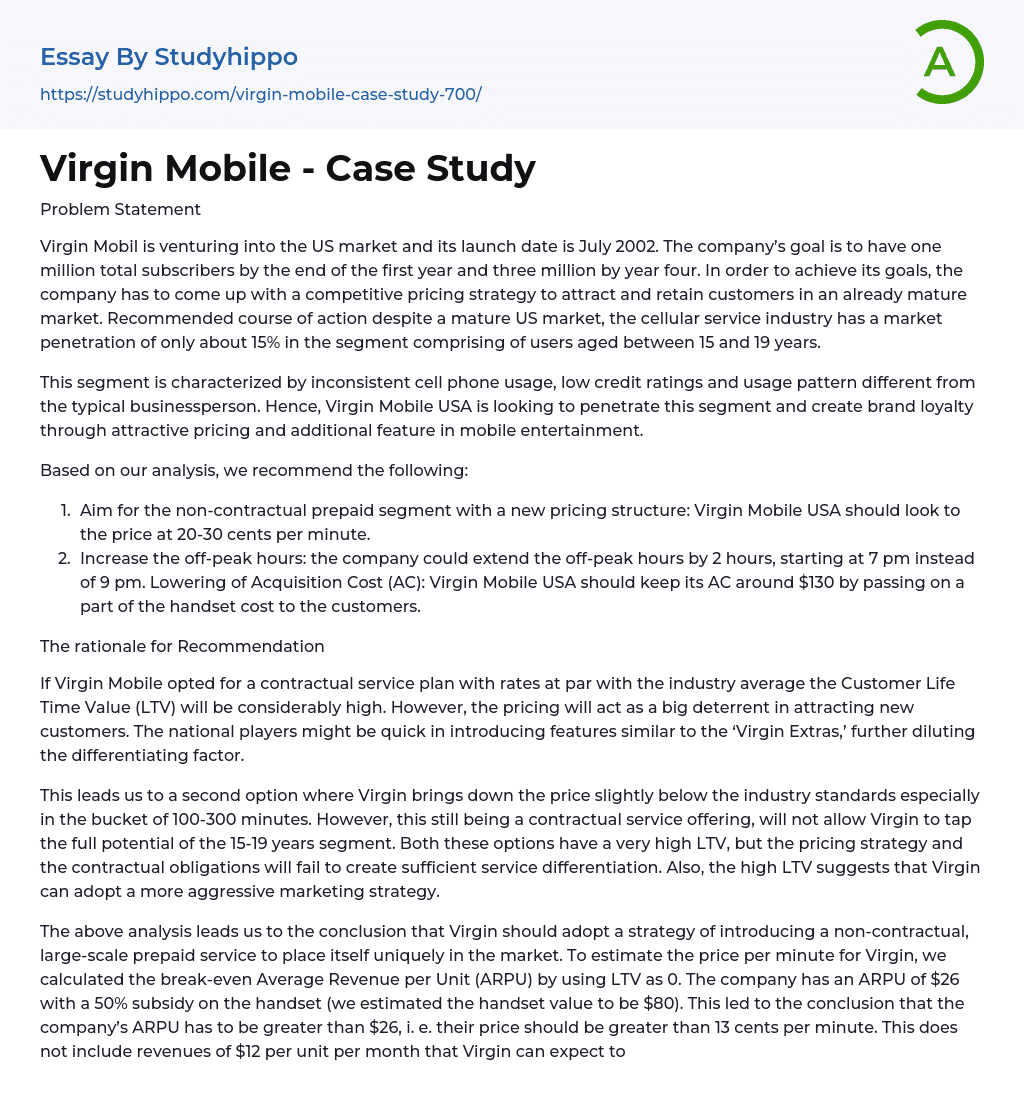Problem Statement
Virgin Mobil is venturing into the US market and its launch date is July 2002. The company’s goal is to have one million total subscribers by the end of the first year and three million by year four. In order to achieve its goals, the company has to come up with a competitive pricing strategy to attract and retain customers in an already mature market. Recommended course of action despite a mature US market, the cellular service industry has a market penetration of only about 15% in the segment comprising of users aged between 15 and 19 years.
This segment is characterized by inconsistent cell phone usage, low credit ratings and usage pattern different from the typical businessperson. Hence, Virgin Mobile USA is looking to penetrate this segment and create brand loyalty through attractive pricing and additional feature in mobile en
...tertainment.
Based on our analysis, we recommend the following:
- Aim for the non-contractual prepaid segment with a new pricing structure: Virgin Mobile USA should look to the price at 20-30 cents per minute.
- Increase the off-peak hours: the company could extend the off-peak hours by 2 hours, starting at 7 pm instead of 9 pm. Lowering of Acquisition Cost (AC): Virgin Mobile USA should keep its AC around $130 by passing on a part of the handset cost to the customers.
The rationale for Recommendation
If Virgin Mobile opted for a contractual service plan with rates at par with the industry average the Customer Life Time Value (LTV) will be considerably high. However, the pricing will act as a big deterrent in attracting new customers. The national players might be quick in introducing features similar to the ‘Virgin
Extras,’ further diluting the differentiating factor.
This leads us to a second option where Virgin brings down the price slightly below the industry standards especially in the bucket of 100-300 minutes. However, this still being a contractual service offering, will not allow Virgin to tap the full potential of the 15-19 years segment. Both these options have a very high LTV, but the pricing strategy and the contractual obligations will fail to create sufficient service differentiation. Also, the high LTV suggests that Virgin can adopt a more aggressive marketing strategy.
The above analysis leads us to the conclusion that Virgin should adopt a strategy of introducing a non-contractual, large-scale prepaid service to place itself uniquely in the market. To estimate the price per minute for Virgin, we calculated the break-even Average Revenue per Unit (ARPU) by using LTV as 0. The company has an ARPU of $26 with a 50% subsidy on the handset (we estimated the handset value to be $80). This led to the conclusion that the company’s ARPU has to be greater than $26, i. e. their price should be greater than 13 cents per minute. This does not include revenues of $12 per unit per month that Virgin can expect to earn from mobile entertainment. The company needs to have a healthy LTV as it has high fixed costs associated with the MVNO model it has with Sprint. Hence, the company should charge the customers between 20-30 cents per minute giving it an LTV of over 100, simultaneously allowing it to distinguish itself in an industry, which has an average price between 35-50 cents per minute for prepaid services.
To make its product even
more lucrative to the target segment, Virgin Mobil could extend the off-peak hours by 2 hours thus bringing down the actual price by 3 cents a minute and which the company should look to advertise to attract more customers.
- Advertising essays
- Audience Theory essays
- Competitor Analysis essays
- Consumer essays
- Marketing Management essays
- Marketing Mix essays
- Marketing Plan essays
- Marketing Research essays
- Marketing Strategy essays
- Point Of Sale essays
- Price essays
- Procurement essays
- Product essays
- Product Differentiation essays
- Promotion essays
- Promotion And Marketing Communications essays
- Retailing essays
- Trademark essays
- Anheuser-busch essays
- Brands essays
- Detergent essays
- Product Placement essays
- Research Design essays
- New Product Development essays
- Advertisement essays
- Brand essays
- Sales Promotion essays
- Advertising campaign essays
- Consumer behaviour essays
- Offer And Acceptance essays
- Wal-Mart essays
- Discover essays
- Gas prices essays
- Accounting essays
- Andrew Carnegie essays
- Automation essays
- Business Cycle essays
- Business Intelligence essays
- Business Model essays
- Business Operations essays
- Business Software essays
- Cooperation essays
- Cooperative essays
- Corporate Social Responsibility essays
- Corporation essays
- Customer Relationship Management essays
- Family Business essays
- Franchising essays
- Harvard Business School essays
- Harvard university essays




